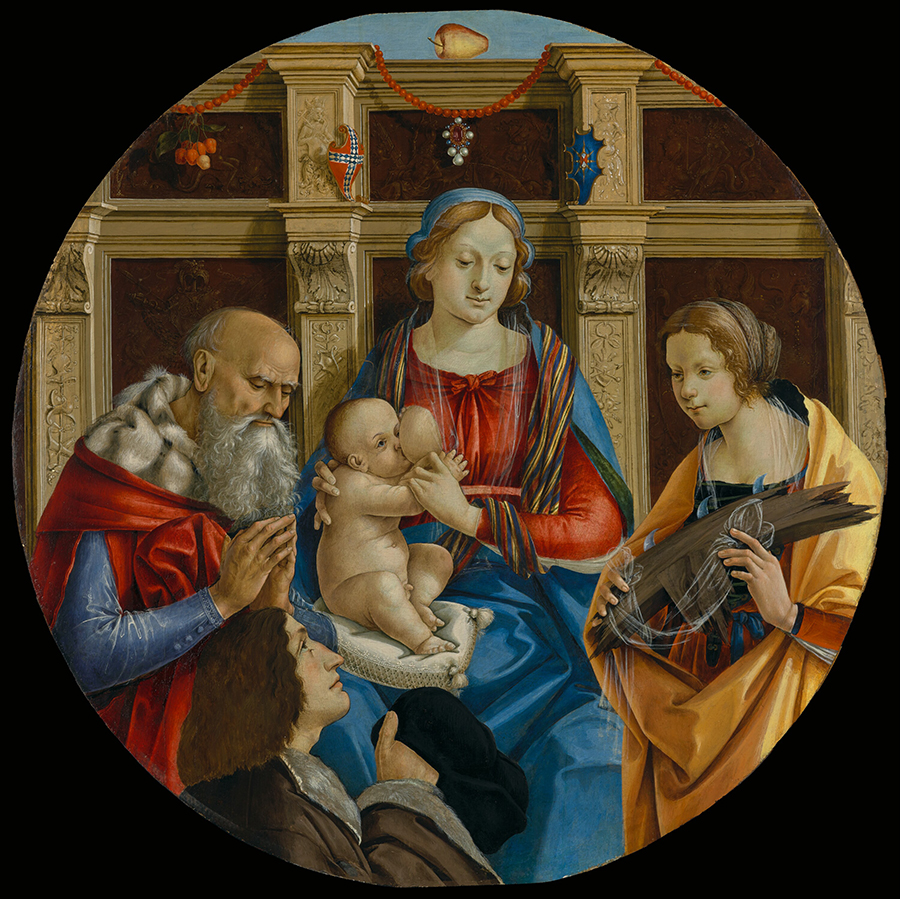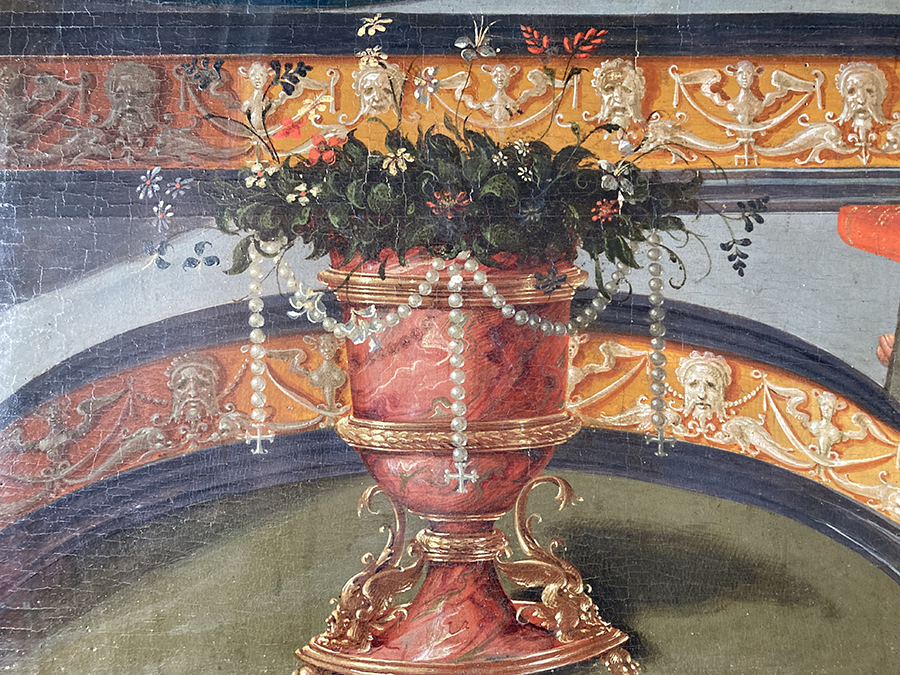Christopher Daly
Painting in Lucca in the Late 15th Century: A Problem in Artistic Geography

Michelangelo di Pietro Membrini, Madonna and Child with Saints Jerome, Catherine of Alexandria and a Donor, c. 1496, tempera on panel, J. Paul Getty Museum, Los Angeles
In 1906 Bernard Berenson (1865–1959), the famous American art historian and critic, published a large tondo of the Madonna and Child with a donor and Saints Jerome and Catherine of Alexandria. Then in the collection of the New York painter Francis Augustus Lathrop (1849–1909) and now at the J. Paul Getty Museum in Los Angeles, the painting was intriguing to Berenson because of its anonymous authorship and style. To his eye, it revealed a “singular mixture, the types, hands, and draperies showing the influence of Domenico Ghirlandaio [1449–1494] and Filippino Lippi [1457–1504], but also a touch of the Flemish.” This stylistic confection led him to suggest a painter active in Lucca, the long-independent mercantile republic west of Florence for which Ghirlandaio and Filippino both worked in the 1480s and whose commercial ties to the Low Countries led to steady importation of Netherlandish paintings. Interestingly, however, Berenson was hesitant to identify the artist as Lucchese outright, claiming that “despite Lucca’s fecundity in the field of medieval architecture, it lacked any true Renaissance painters.” He therefore left the painter’s origins open, christening him the Master of the Lathrop Tondo, assigning him a small corpus of additional works, and finally expressing his hope that “someday, some diligent researcher will enter the Lucchese state archives and uncover this painter’s true name and nationality.” As fate would have it, this is precisely what happened when, almost 80 years later, a team of art historians and archivists scoured the Lucchese state archives, recovering dozens of documents related to the painter’s works. These records revealed that he was none other than Michelangelo di Pietro Membrini (c. 1461/1464–1525), one of the foremost painters of Renaissance Lucca, yet but one of many to animate its artistic landscape.
My dissertation, completed and defended during my year at the Center, focuses on this generation of Lucchese painters to examine how the art production in a region typically described as “provincial” or “peripheral” can help us rethink the supremacy of a canonical “center.” Lucca is a suitable case study for this analysis because each of the painters based in the city during this period emerged in scholarship in the same manner as Membrini: as hypothetical “Masters” invented by connoisseurs on the basis of detectable influences in their works. As a result, the Lucchese have traditionally—and paradoxically—been cast as a school of homogeneous eclectics, their styles based on those of their more famous contemporaries, with the Florentines Ghirlandaio and Filippino cited as the main sources of inspiration. I argue, however, that aside from being contradictory in its notion of a homogeneous eclecticism, this assessment minimizes the ambition and originality of Lucchese painting, overlooking the dynamic patterns of mobility, dialogue, and exchange evidenced in these painters’ works and archival biographies. Moving beyond anachronistic and geographically biased notions of unidirectional “influence,” my study emphasizes these artists’ idiosyncrasies while reconstructing key aspects of their creative environment. In four chapters, it considers their partnerships (compagnie) and collaborations, their methods of citation, the demands of their patrons, and the instances in which they traveled beyond their native city. Together, these chapters offer a more nuanced, historically grounded account of Lucchese painting, revealing the myriad ways in which the city’s artists critically engaged with both local and foreign contemporaries. Further, in expanding the rigid geographic borders of Italian Renaissance art history, my dissertation demands a broader rethinking of the notion of influence, of how style is tethered to location, and of how the term “eclecticism” is mobilized—often indiscriminately—in the discipline of art history.

Michelangelo di Pietro Membrini, Madonna and Child with Saints James and Christopher (detail), c. 1502/1508, tempera on panel, Casa Canonica, Santa Maria e San Jacopo a Lammari, Capannori
The dissertation concludes with the first-ever catalogues raisonnés for each Lucchese painter active circa 1465 to circa 1525 for whom a corpus can be reconstructed: Matteo Civitali (1436–1501), Baldassarre di Biagio (first doc. 1437; died 1482/1484), the Master of San Paolino (active third quarter of the 15th century), Michele Ciampanti (doc. 1463–1521), Vincenzo Frediani (1458–1505), Antonio Corsi (doc. 1465–1516), Vincenzo Civitali (doc. 1488–1530), Membrini, Sano Ciampanti (1474–1532/1535), and Ranieri di Leonardo (doc. 1500–1521). The catalogues raisonnés present many new discoveries, most made during my two years abroad on my Center fellowship, examining Lucchese paintings in collections across Europe and the United States. As they continue to grow and develop with an eye toward eventual publication, I hope they can offer a groundwork for future research.
Johns Hopkins University
David E. Finley Fellow, 2021–2024
In September 2024, Christopher Daly will join the Metropolitan Museum of Art as the Andrew W. Mellon Postdoctoral Curatorial Fellow in the Robert Lehman Collection.
